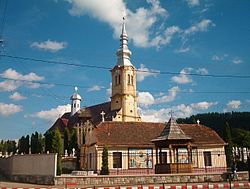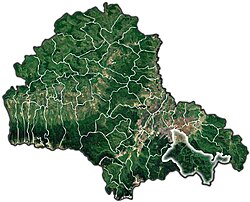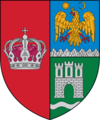Săcele
This article needs additional citations for verification. (December 2013) |
Săcele
Szecseleváros | |
|---|---|
Municipality | |
 | |
 Location of Săcele | |
 Location in Brașov County | |
| Lua error in Module:Location_map at line 526: Unable to find the specified location map definition: "Module:Location map/data/Romania Brasov" does not exist. | |
| Coordinates: 45°37′12″N 25°42′35″E / 45.62000°N 25.70972°E | |
| Country | |
| County | Brașov County |
| Status | Municipality |
| Government | |
| • Mayor | Popa Virgil (Social Democratic Party) |
| Area | |
| • Total | 320 km2 (120 sq mi) |
| Lowest elevation | 650 m (2,130 ft) |
| Population (2011) | |
| • Total | 30,798 |
| Time zone | UTC+2 (EET) |
| • Summer (DST) | UTC+3 (EEST) |
| Website | http://www.municipiulsacele.ro/ |
Săcele (Romanian pronunciation: [səˈt͡ʃele]; German: Siebendörfer; Hungarian: Négyfalu, between 1950 and 2001 Szecseleváros) is a city in Brașov County, Romania, in the region of Transylvania, with a population of 30,798 inhabitants in 2011. It is adjacent to the city of Brașov, its city centre being situated 15 km away from downtown Brașov.
History
The city since 1950 is composed of former villages which now form the main sectors: Baciu (Bácsfalu, Batschendorf), Turcheș (Türkös, Türkeschdorf), Cernatu (Csernátfalu, Zerndorf) and Satulung (Hosszúfalu, Langendorf).
After the second half of the 11th century the villages are mentioned as "septem villae valacheles" (seven Vlach villages).
The first official mention is an act issued on May 16, 1366, by the Hungarian King Ludovic I de Anjou in which he offers the area between the Timiş and Olt rivers to a trusted friend—Count Stanislav. Later it was under the Saxon management of Kronstadt (Brașov).
During the Middle Ages three other villages belonged to the nowadays four, those three were: Tărlungeni, Zizin and Cărpiniș.
The Romanian name "Săcele" is first mentioned in a letter between the Wallachian Prince Vlad Călugărul (1482–1495) and the magistrate of Braşov.The Romanian etymology of "Săcele" is from "sătucele" meaning "small villages".
The German name was "Siebendörfen" which means "seven villages" and which is close to the Hungarian name "Hétfalu" or "Négyfalu".
The inhabitants were the "mocani"—local shepherds. They are mentioned in a few official documents and appear to have owned thousands of sheep, the villages being among the wealthiest in the area. They carried the local traditions across many Romanian lands due to the transhumance method of shepherding.
Their customs exist to these days: the "Sintilie" (Saint Elijah) festival, national costumes, etc.
Between the 13th and 14th centuries, an important Hungarian population has established in the region and marked the further development of the area.
After the fall of Communism in Romania in 1990, the city has diversified its economy. In Săcele there are nowadays several small furniture factories, lumber-mills, as well as meat-packaging facilities.
Buildings
The city has 17 churches of the following denominations: Orthodox, Lutheran, Reformed, Roman Catholic.
Sport
Football team: Precizia Săcele (playing in the 4th League).
Population
| Year | Pop. | ±% |
|---|---|---|
| 1956 | 18,365 | — |
| 1966 | 22,809 | +24.2% |
| 1977 | 30,551 | +33.9% |
| 1992 | 30,226 | −1.1% |
| 2002 | 29,967 | −0.9% |
| 2011 | 26,907 | −10.2% |
| Source: Census data | ||
According to the 2011 census, the town has a population of 26,907 of which 75.1% are Romanians, 23% Hungarians, 1.2% Roma and 0.2% Germans. At the 2002 census, 69% were Romanian Orthodox, 15.2% Evangelical Lutheran, 4.9% Roman Catholic, 3.4% each Reformed and Pentecostal, 1.1% belong to "another religion" and 0.5% Unitarian.
International relations
Twin towns – Sister cities
Săcele is twinned with:
Gallery
-
View over Săcele
-
The Monument of the Unknown Soldiers
-
Dormition of the Theotokos Church
Natives
References
- ^ "National Commission for Decentralised cooperation". Délégation pour l’Action Extérieure des Collectivités Territoriales (Ministère des Affaires étrangères) (in French). Archived from the original on 2013-11-27. Retrieved 2013-12-26.
{{cite web}}: Unknown parameter|deadurl=ignored (|url-status=suggested) (help)




